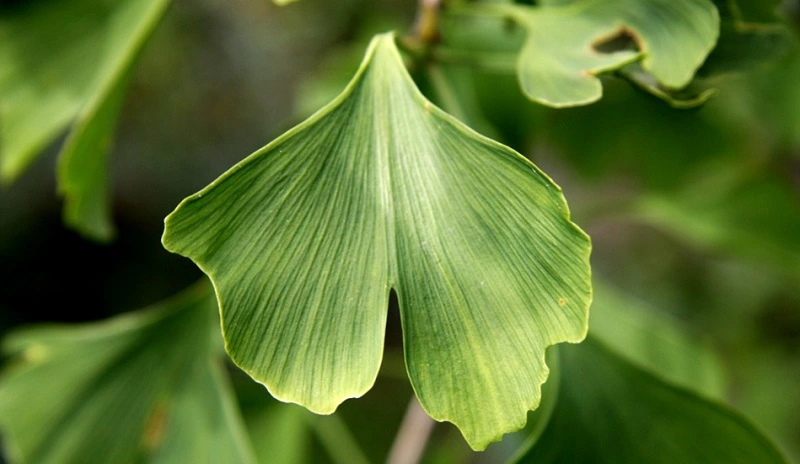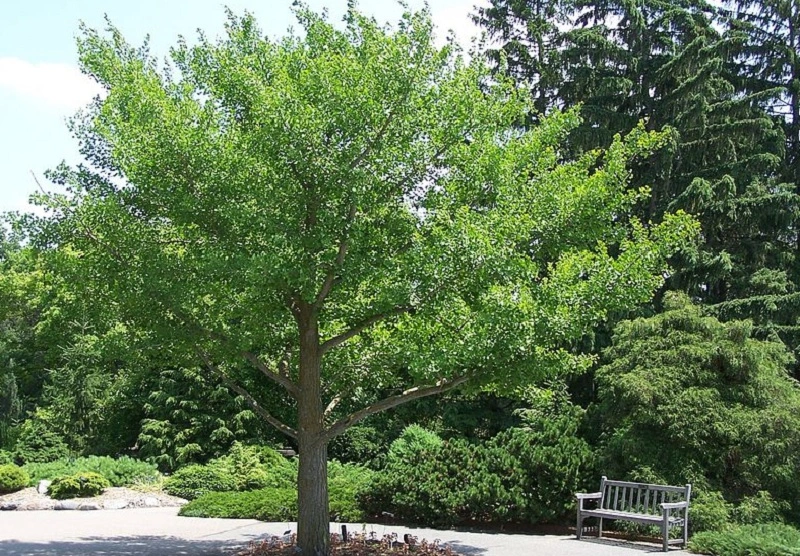Ginkgo biloba – how and why to grow it.
Ginkgo biloba is a unique, relict plant. Taoist monks consider it a symbol of yin and yang energy, a keeper of wisdom.
Ginkgo belongs to dioecious plants (there are female and male trees). Botanically, ginkgo is closest to conifers. Ginkgo has long been classified as gymnosperms, representatives of which are also pine and spruce trees. But ginkgo is very different from modern conifers, and scientists have assumed that ginkgo biloba is a direct descendant of ancient ferns, widespread in the Mesozoic era, whose habitat extended to the territory of modern Siberia. Today, wild thickets of these trees are found in China and on the Black Sea coast (a little, but there are).
Ginkgo biloba is a deciduous plant with a unique leaf shape: the leaf looks like a fan, the width of which reaches 8 cm.
A large leaf is supported by a thin long petiole (up to 10 cm). The ginkgo tree has one peculiarity – it is possible to determine whether this dioecious plant belongs to the male or female type only when it is 25 or 30 years old, distinctive signs do not appear earlier. Representatives of the male type have earrings, it is in them that the pollen is located. The female plant has rudiments, in which the seed binding process takes place. The main role in pollination is played by the wind, thanks to which the pollen flies over long distances. Ginkgo biloba fruits ripen before the beginning of winter. The description of the tree would not be complete if we did not mention the seeds. The seeds also have their own characteristics – this is an unpleasant smell and a skin that covers them in three layers. The name of the genus Ginkgo in translation from Japanese means “silver apricot”, connected with the similarity of ginkgo seeds to apricot fruits with silver pubescence. Legends tell that in very ancient times, ginkgo seeds were accepted as a tribute. The word biloba in Latin means two lobes – most leaves are divided into two halves. Ginkgo biloba seeds are similar to apricot or plum seeds – orange-yellow, in China, boiled or fried ginkgo seeds are eaten in the growing areas.

Useful properties of ginkgo biloba
Since ancient times, the healing properties of ginkgo have been used in Chinese medicine.
The healing properties of ginkgo biloba are used in modern medicine in many countries. The main medicinal raw material is Ginkgo biloba leaves. The main medicinal properties of the Ginkgo biloba plant:
- It is a powerful antioxidant. It fights free radicals even more effectively than vitamin E and prevents premature aging, prevents the oxidation of low-density lipoproteins and the development of atherosclerosis.
- Improves blood circulation both in large vessels – veins and arteries, and in capillaries. Thanks to this, the oxygen supply to all organs and tissues is restored. Breathing and heart work improves, heart rhythm stabilizes, brain activity, memory and intellectual abilities are restored. Slows down the development of Alzheimer’s disease.
- Helps with dizziness, reduced hearing and vision.
- It is effective in the treatment of impotence, intermittent lameness, premenstrual syndrome, insomnia and depression. Relieves attacks of bronchial asthma, protects the liver, relieves the condition of hemorrhoids.
- Improves the rheological parameters of blood, prevents the sticking of platelets and the formation of blood clots.
- Reduces insulin consumption and is an indispensable component in the treatment of diabetic angiopathy.
- Prevents the development of metastases in malignant tumors.
- Used in cosmetology. It is used in cosmetic products that prevent skin aging, the effect of “orange peel” and puffiness.
Cultivation of ginkgo biloba
You can propagate a rare tree with the help of seeds and shoots. Branches should be taken from adult trees, it is best when it is already known for sure whether it is a male or a female specimen. Cut cuttings are rooted in greenhouses in light soil.
This operation should be started in the first half of summer. When rooting cuttings cut from the mother plant with part of the wood, it is useful to use stimulators of root formation. Leaves are removed from the stem up to 50%. With seed propagation, growth directly depends on the freshness of the seeds. The seeds of the plant resemble an apricot pit, only they are white in color. Seeds can be sown in early spring. They are placed in boxes to a depth of 7 cm. The film shelter will increase the percentage of seed germination and shorten the period of obtaining young plants. Ginkgo sprouts begin to appear about a month after sowing. Trees grow slowly, giving very little growth. Seedlings can be planted in a permanent place after a year. When choosing a place to plant a tree, you should immediately assume that the plant needs a very large area, while the location should be the brightest – ginkgo is a light-loving culture.
Where to plant ginkgo biloba
You need to choose a permanent place for growing – the tree does not tolerate transplant very well. In the first years of life, for about three years, culture practically does not give growth. At this time, the development and strengthening of the root system takes place.
How to plant ginkgo biloba
Seedlings are placed in special pits filled with fertile soil. When planting, you must strictly monitor the location of the roots – they must be spread out and located freely in the pit. It requires uniform periodic watering – you cannot dry the roots in the first years of life.
Care for ginkgo biloba
Caring for a young tree is reduced to periodic watering, loosening the soil and freeing the plant from weeds. Ginkgo is a very undemanding tree that tolerates many environmental conditions. This tree is not afraid of insects and pests and has good frost resistance, and it cannot be harmed by strong air pollution or smoke. But a cold and damp summer, when the shoots do not have the opportunity to ripen, can harm the plant. Follow our recommendations and let growing a relic tree in the garden and caring for it bring you many pleasant moments and a good mood.

